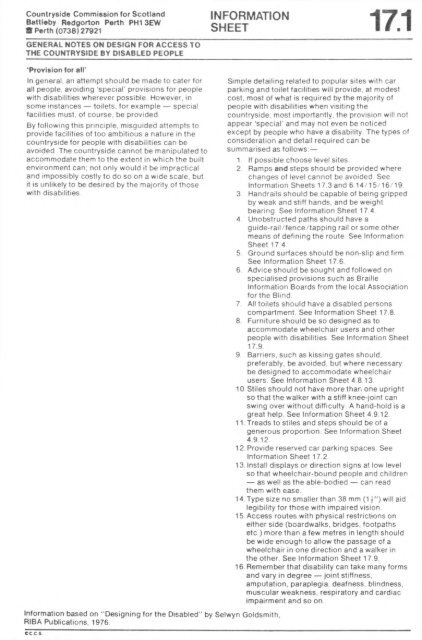information - Scottish Natural Heritage
information - Scottish Natural Heritage
information - Scottish Natural Heritage
You also want an ePaper? Increase the reach of your titles
YUMPU automatically turns print PDFs into web optimized ePapers that Google loves.
Countryside Commission for Scotland<br />
Battleby Redgorton Perth PH13EW<br />
Perth (0738) 27921<br />
GENERAL NOTES ON DESIGN FOR ACCESS TO<br />
THE COUNTRYSIDE BY DISABLED PEOPLE<br />
'Provision for all'<br />
In general, an attempt should be made to cater for<br />
all people, avoiding 'special' provisions for people<br />
with disabilities wherever possible However, in<br />
some instances — toilets, for example — special<br />
facilities must, of course, be provided<br />
By following this principle, misguided attempts to<br />
provide facilities of too ambitious a nature in the<br />
countryside for people with disabilities can be<br />
avoided The countryside cannot be manipulated to<br />
accommodate them to the extent in which the built<br />
environment can; not only would it be impractical<br />
and impossibly costly to do so on a wide scale, but<br />
it is unlikely to be desired by the majority of those<br />
with disabilities.<br />
Information based on "Designing for the Disabled" by Selwyn Goldsmith,<br />
RIBA Publications, 1976<br />
©c.c s<br />
INFORMATION<br />
SHEET<br />
17.1<br />
Simple detailing related to popular sites with car<br />
parking and toilet facilities will provide, at modest<br />
cost, most of what is required by the majority of<br />
people with disabilities when visiting the<br />
countryside; most importantly, the provision will not<br />
appear 'special' and may not even be noticed<br />
except by people who have a disability. The types of<br />
consideration and detail required can be<br />
summarised as follows:—<br />
I. If possible choose level sites.<br />
2 Ramps and steps should be provided where<br />
changes of level cannot be avoided See<br />
Information Sheets 17.3 and 6 14/15/16/19.<br />
3 Handrails should be capable of being gripped<br />
by weak and stiff hands, and be weight<br />
bearing. See Information Sheet 17.4<br />
4 Unobstructed paths should have a<br />
guide-rail/fence/tapping rail or some other<br />
means of defining the route See Information<br />
Sheet 17.4<br />
5. Ground surfaces should be non-slip and firm.<br />
See Information Sheet 17.6<br />
6. Advice should be sought and followed on<br />
specialised provisions such as Braille<br />
Information Boards from the local Association<br />
for the Blind<br />
7. All toilets should have a disabled persons<br />
compartment. See Information Sheet 17.8.<br />
8. Furniture should be so designed as to<br />
accommodate wheelchair users and other<br />
people with disabilities. See Information Sheet<br />
17.9<br />
9. Barriers, such as kissing gates should,<br />
preferably, be avoided, but where necessary<br />
be designed to accommodate wheelchair<br />
users. See Information Sheet 4 8.13.<br />
10. Stiles should not have more thar, one upright<br />
so that the walker with a stiff knee-joint can<br />
swing over without difficulty. A hand-hold is a<br />
great help See Information Sheet 4 9.12.<br />
II. Treads to stiles and steps should be of a<br />
generous proportion. See Information Sheet<br />
4.9 12.<br />
12 Provide reserved car parking spaces See<br />
Information Sheet 17.2.<br />
13. Install displays or direction signs at low level<br />
so that wheelchair-bound people and children<br />
— as well as the able-bodied — can read<br />
them with ease.<br />
14. Type size no smaller than 38 mm (1 J") will aid<br />
legibility for those with impaired vision.<br />
15. Access routes with physical restrictions on<br />
either side (boardwalks, bridges, footpaths<br />
etc.) more than a few metres in length should<br />
be wide enough to allow the passage of a<br />
wheelchair in one direction and a walker in<br />
the other. See Information Sheet 17 9.<br />
16 Remember that disability can take many forms<br />
and vary in degree — joint stiffness,<br />
amputation, paraplegia, deafness, blindness,<br />
muscular weakness, respiratory and cardiac<br />
impairment and so on

















